| Volume
88
October 22 - November 26
The Return Trip Part Two - San Juanico to Mazatlan
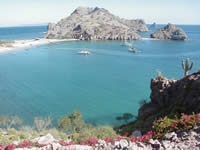 The
social life of Concepcion was a harbinger of the next three weeks.
Suddenly we were back in a pack of cruisers. Some were folks we
had been traveling with on and off through the summer months, while
others were cruisers re-embarking from the storage yard in San Carlos
where they’d left their boats to escape the summer heat. The
social life of Concepcion was a harbinger of the next three weeks.
Suddenly we were back in a pack of cruisers. Some were folks we
had been traveling with on and off through the summer months, while
others were cruisers re-embarking from the storage yard in San Carlos
where they’d left their boats to escape the summer heat.
It seems there are a
bunch of different understandings about what is the “cruising
season” in the Sea of Cortez. In the winter months the area
can be beset by “northers,” strong winds from the northwest
that can blow hard (and cold) for days at a time, sometimes pinning
a boat down in an anchorage and keeping its occupants hunkered down
inside! In the summer, however, there are only very light winds
from the south and temperatures can get quite hot, plus there is
hurricane season to fret over as well as the potential localized
winds – Chubascos, Corumuels and Elefantes – mentioned
in the last Logbook Update.
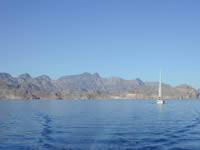 Most
West Coast cruisers bound for Mexico come down in the late fall,
many of them with the organized Baja HaHa Rally. This gets them
to the tip of Baja – Cabo San Lucas – just about the
beginning of November. Many of them have plans to “cruise
the Sea” a bit before turning south to winter on the mainland,
but this year at least, the north winds started early and the newbies
have been struggling to get as far North as La Paz. In our book,
this does not constitute “cruising the Sea!” Most
West Coast cruisers bound for Mexico come down in the late fall,
many of them with the organized Baja HaHa Rally. This gets them
to the tip of Baja – Cabo San Lucas – just about the
beginning of November. Many of them have plans to “cruise
the Sea” a bit before turning south to winter on the mainland,
but this year at least, the north winds started early and the newbies
have been struggling to get as far North as La Paz. In our book,
this does not constitute “cruising the Sea!”
Similarly, cruisers
who have passed a winter season on the mainland (southern Pacific
Mexico is a serious hurricane risk zone in summer), come north to
the Sea about May. Some will summer over in the Sea like we did,
but by far the bulk of them will store the boat in La Paz or San
Carlos and boogie on out. What we find amazing about this is how
many of them were gone this year by mid-June! The water had barely
gotten warm enough to swim in!
While some cruisers only
store the boat for the worst month or two of heat and hurricane
season, others are gone until November and do their “cruising”
of the Sea on the return pass southward. Even though San Carlos
is on the mainland coast, the easiest and usual route to take (because
the mainland coast is plagued by shallows and few anchorages) involves
crossing the Sea twice and doing your north-south travel on the
Baja side. This strategy obviously limits the experience of the
Sea to just a few weeks.
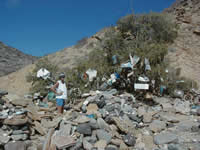 Anyway,
as we headed farther south, the number of boats around was being
increased by cruisers returning from San Carlos. Tackless II
motored south from Concepcion in company with Lady Galadriel,
most of the others having gone on ahead. In San Juanico, where we
had been alone on our way north, this time we shared the anchorage
with ten other boats! There was no tucking behind the Moon Rocks
for more than one or two of us, but to our amazement the southeasterly
winds we had by day never mounted a swell, while the nighttime westerlies
kept the wind generator cranking. Everybody kept busy with kayaking,
snorkeling, hunting, hiking, and moving from boat to boat for dinner
gatherings. We even had a potluck cocktail party on the yellow sandstone
rock formation below the fancy houses, to which we invited five
people cruising for a week on a 27’ O’Day bareboat! Anyway,
as we headed farther south, the number of boats around was being
increased by cruisers returning from San Carlos. Tackless II
motored south from Concepcion in company with Lady Galadriel,
most of the others having gone on ahead. In San Juanico, where we
had been alone on our way north, this time we shared the anchorage
with ten other boats! There was no tucking behind the Moon Rocks
for more than one or two of us, but to our amazement the southeasterly
winds we had by day never mounted a swell, while the nighttime westerlies
kept the wind generator cranking. Everybody kept busy with kayaking,
snorkeling, hunting, hiking, and moving from boat to boat for dinner
gatherings. We even had a potluck cocktail party on the yellow sandstone
rock formation below the fancy houses, to which we invited five
people cruising for a week on a 27’ O’Day bareboat!
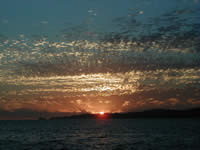 Hurricane
season does not officially end until November, and this year Mother
Nature took us to the wire with Hurricane Kenna. Late season hurricanes
in the Eastern Pacific are the ones most likely to threaten the
Sea and are notoriously unpredictable. We woke up in San Juanico
one day to a building hurricane Kenna, which seemed to have sprung
from nowhere. Nobody wanted to leave San Juanico, one of the nicest
anchorages in Baja, but all stood poised to dash 76 miles back to
Concepcion or 36 miles south to crowded Puerto Escondido depending
on the storms track. Fortunately for us, Kenna never wavered from
its predicted course, but unfortunately for the mainland coast south
of Mazatlan it was a full-blown category V storm when it blew ashore
there. San Blas, which we had enjoyed visiting back in May, was
hit hard: roofs blown off, palapas wiped away, huge old trees toppled,
mangroves burnt by salt, and even the ruins of the old fort where
Don and I posed for photos were knocked down. Miraculously, no one
was reported killed. Even Puerto Vallarta, which has smugly claimed
that it has never been hit by a hurricane, had fifteen foot waves
two or three blocks inland on the Malecon. Reports have it that
most beachfront businesses were damaged and many of the statues
lining the “boardwalk” have gone missing. Hurricane
season does not officially end until November, and this year Mother
Nature took us to the wire with Hurricane Kenna. Late season hurricanes
in the Eastern Pacific are the ones most likely to threaten the
Sea and are notoriously unpredictable. We woke up in San Juanico
one day to a building hurricane Kenna, which seemed to have sprung
from nowhere. Nobody wanted to leave San Juanico, one of the nicest
anchorages in Baja, but all stood poised to dash 76 miles back to
Concepcion or 36 miles south to crowded Puerto Escondido depending
on the storms track. Fortunately for us, Kenna never wavered from
its predicted course, but unfortunately for the mainland coast south
of Mazatlan it was a full-blown category V storm when it blew ashore
there. San Blas, which we had enjoyed visiting back in May, was
hit hard: roofs blown off, palapas wiped away, huge old trees toppled,
mangroves burnt by salt, and even the ruins of the old fort where
Don and I posed for photos were knocked down. Miraculously, no one
was reported killed. Even Puerto Vallarta, which has smugly claimed
that it has never been hit by a hurricane, had fifteen foot waves
two or three blocks inland on the Malecon. Reports have it that
most beachfront businesses were damaged and many of the statues
lining the “boardwalk” have gone missing.
 A
week later, after the weather window was clear, we sailed south
again with Lady Galadriel to anchor for several days on the
south side of Isla Coronados. This island was one of our favorites
on the way up, and it was a favorite again this time. The highlight
was a joint snorkel excursion up the east coast where we found excellent
visibility revealing a dramatic rock-scape with many fish and even
dolphins! In the whole summer these were the only dolphins we saw
while in the water! A
week later, after the weather window was clear, we sailed south
again with Lady Galadriel to anchor for several days on the
south side of Isla Coronados. This island was one of our favorites
on the way up, and it was a favorite again this time. The highlight
was a joint snorkel excursion up the east coast where we found excellent
visibility revealing a dramatic rock-scape with many fish and even
dolphins! In the whole summer these were the only dolphins we saw
while in the water!
From Coronados
we revisted the Puerto Ballandra and Candeleros anchorages. This
last was stunningly green compared to our first visit, and this
time we hiked up to the little Danzante Resort (www.danzante.com)
which perches on a hilltop overlooking the bay. We four were hoping
to indulge in a restaurant meal, but the resort was full and had
no room for outsiders. The view was reward enough, though, and we
went home and cooked pretty much the same meal aboard as we would
have been served!
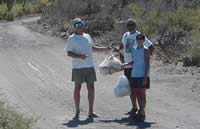 Our
next stop was Aguaverde where we found eight boats already at anchor,
all of them squeezed tight into the small northern cove. We found
out why after sunset when our more exposed spot was set to big-time
rock and roll! After a sleepless night we elbowed our way after
coffee to the head of the cove practically anchoring on the beach
among the pangas. This put us in a fine position when the one of
the season’s first northers kicked in keeping us all put for
several days with winds over 25 knots. There was no beaching the
dinghy on the town beach this time, so for provisions, goat cheese
and trash we all had to hike several miles through the hills to
get to town. Like Candeleros, Aguaverde had undergone a major transformation,
with the hills blushed with bright green and even with flowers! Our
next stop was Aguaverde where we found eight boats already at anchor,
all of them squeezed tight into the small northern cove. We found
out why after sunset when our more exposed spot was set to big-time
rock and roll! After a sleepless night we elbowed our way after
coffee to the head of the cove practically anchoring on the beach
among the pangas. This put us in a fine position when the one of
the season’s first northers kicked in keeping us all put for
several days with winds over 25 knots. There was no beaching the
dinghy on the town beach this time, so for provisions, goat cheese
and trash we all had to hike several miles through the hills to
get to town. Like Candeleros, Aguaverde had undergone a major transformation,
with the hills blushed with bright green and even with flowers!
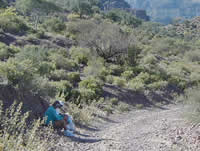 The
norther that besieged us in Aguaverde was the first of a series.
In the first break we zipped down to Evaristo just in time to get
pinned down again! Interestingly, of all the places we stopped northbound,
Evaristo was one we hadn’t cared for. Yet this time, anchored
away from town in Entrance Cove, we liked it much better. It too
was greener, and in the cooler temps we enjoyed hiking around (in
search of the dump!). The next jump took four of us to the south
side of San Jose, where we enjoyed a day’s grace before we
skedaddled for cover again, this time to Isla San Francisco! The
norther that besieged us in Aguaverde was the first of a series.
In the first break we zipped down to Evaristo just in time to get
pinned down again! Interestingly, of all the places we stopped northbound,
Evaristo was one we hadn’t cared for. Yet this time, anchored
away from town in Entrance Cove, we liked it much better. It too
was greener, and in the cooler temps we enjoyed hiking around (in
search of the dump!). The next jump took four of us to the south
side of San Jose, where we enjoyed a day’s grace before we
skedaddled for cover again, this time to Isla San Francisco!
San Francisco’s
Hook anchorage had protected us from strong southerlies back in
June. This time we tucked in a line up under the north cliff face
to hide from yet another norther and spent a very pleasant three
days hiking by day and doing round robin potluck dinners by night.
The anchorage was so cozy we could almost forget the wind, but up
on the island’s ridge top our hats kept trying to set sail!
For the last
several weeks, we had felt like we were stealing time, stretching
summer vacation day by day by day, enjoying ourselves more and more
and stubbornly not wanting it to end! Our day of reckoning dawned
on Sunday, November 17, when we had to break up our happy group.
Our airline flights back Stateside were barely a week away, and
the weather forecast finally suggested we might have a break for
the two-day crossing to Mazatlan. Incredibly it appeared to be perfect
timing for both the full moon AND the Leonid meteor showers expected
for the wee hours of November 19. At sunrise we hoisted the anchor,
with Katherine and Alan on The Good Neighbor behind us, and
poked our nose out around the corner to see if the winds had subsided
as reported.
Well, that would be a
sort of… We motored sloppily our first hour, before the wind
filled in from the north at 20 knots! We had, of course, just shaken
out the reef not ten minutes before the wind filled, so we had to
take it in again. The seas were still quite steep, but with the
wind on the beam, the main reefed, the staysail and about a 1/3
genoa we found ourselves flying at a steady 7-8 knots! A CSY at
eight knots!!! This maintained for the whole day and was surprisingly
comfortable.
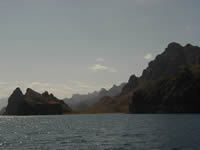 More
amazing, we engaged out Aries windwave and let it steer. These are
just the conditions it relishes, and although it definitely wanders
right and left of course, the course made good every hour was right
on the money! And no amp consumption! More
amazing, we engaged out Aries windwave and let it steer. These are
just the conditions it relishes, and although it definitely wanders
right and left of course, the course made good every hour was right
on the money! And no amp consumption!
The first night the wind
eased a bit, but we kept up a respectable six knots. By morning
however we were slowing down as the wind fizzled, and even with
all sails flying we finally had to break down and fire up Perky.
The questions was, how fast to motor, as the latest forecast now
threatened a renewed 25 knot + norther by the following morning?
Did we go slow in order to still be at sea for the meteor shower
or did we hustle to get in before the norther?
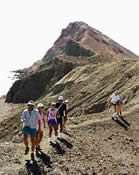 We
hustled. But hustling was going to get us in around one a.m. This
was a situation we are not used to, that is, arriving early at a
destination! The Mazatlan Marina complex has an entrance reputedly
dicey even by day, so we decided the better part of valor was not
to try it at night with a wind and swell building, even under a
full moon. So, instead, we bore off for the old Mazatlan commercial
harbor with its relatively easy entrance. This took us out of our
way by about six miles, but we popped the hook down about 2 am,
presenting us with an impossible dilemma: Do we try to stay awake
for another hour and a half and hope to see some meteors through
the city lights, or do we go to bed! The latter won out, and so,
yet another year, we missed the Leonids. This time, unfortunately,
it is for keeps as the next Leonid meteor shower is not expected
for at least 50 years! We
hustled. But hustling was going to get us in around one a.m. This
was a situation we are not used to, that is, arriving early at a
destination! The Mazatlan Marina complex has an entrance reputedly
dicey even by day, so we decided the better part of valor was not
to try it at night with a wind and swell building, even under a
full moon. So, instead, we bore off for the old Mazatlan commercial
harbor with its relatively easy entrance. This took us out of our
way by about six miles, but we popped the hook down about 2 am,
presenting us with an impossible dilemma: Do we try to stay awake
for another hour and a half and hope to see some meteors through
the city lights, or do we go to bed! The latter won out, and so,
yet another year, we missed the Leonids. This time, unfortunately,
it is for keeps as the next Leonid meteor shower is not expected
for at least 50 years!
But the sleep
sure was welcome. For four hours worth. After that we were chased
out by a stench the source of which we didn’t stay long enough
to identify. The only other sailboat in the anchorage, Meridian
Passage, old friends from Puerto Vallarta (who had kindly talked
us in by radio the night before) was on our heels as we hastened
back north to Marina Mazatlan.
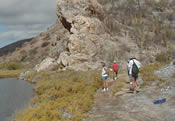 So,
six days later, the boat is in the slip, washed of the summer’s
accumulation of salt and Baja dirt, the deck stripped, the fridge
cleaned out and we are packing to make our Nov 26th flight out.
Although we are not marina lovers by nature, we have taken a fast
liking to this place, yet another kind of funky, capital-compromised
operation, and our first impressions of Mazatlan (not counting the
old harbor!) are very positive. We are optimistic that our project
list can be managed here when we get back January 1, and we are
already back to our regime of daily walks. What more can we ask
for? So,
six days later, the boat is in the slip, washed of the summer’s
accumulation of salt and Baja dirt, the deck stripped, the fridge
cleaned out and we are packing to make our Nov 26th flight out.
Although we are not marina lovers by nature, we have taken a fast
liking to this place, yet another kind of funky, capital-compromised
operation, and our first impressions of Mazatlan (not counting the
old harbor!) are very positive. We are optimistic that our project
list can be managed here when we get back January 1, and we are
already back to our regime of daily walks. What more can we ask
for?
And so, we are Stateside
bound, for the holidays. See you next year.
|












